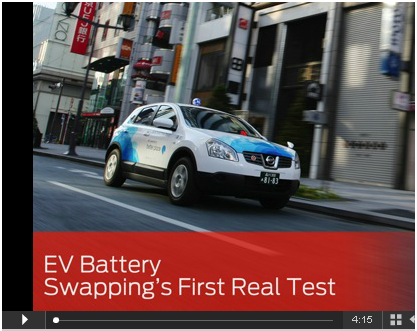Smartphone owners know all about battery anxiety: Spend too long playing games and the battery icon flashes ”empty” the next time you need to make a call. For drivers of electric cars, the problem is more serious: They can’t just walk over with a 20-liter jug of electricity from the nearest charging station, and even if they do manage to glide into a station on their last electrons, it could take hours to top off a car battery. Silicon Valley start-up Better Place claims it can change all that. Its recent trial in Tokyo allowed drivers to switch batteries at stations in minutes, letting them continue their journey and leaving the recharging to Better Place. The company might also help Japan find something to do with its declining number of gas stations, says Minoru Nakamura, head of the crude oil distribution unit of Japan’s ministry of economy, trade, and industry.
The Tokyo trial, which involved three taxis, was the first real-world test for battery swapping. Results from the first four months of the seven-month trial showed that the prototype batteries don’t require any special care—the computer-controlled battery-charging bank was able to keep the batteries in good condition by controlling temperatures and choosing when to charge and use each one. By the end of the trial, on 20 December 2010, Better Place claims the taxi drivers had grown more comfortable using more of the battery between visits to the battery-switching station.
For now, the batteries require recharging every 90 kilometers or so, with plans for a 160-km range on production models. Those distances are nothing special by electric vehicle standards, but Better Place hopes to show that swapping batteries can be just as easy as refilling a tank of gas.
”You’re essentially amortizing the initial investment of batteries over the difference between gasoline price and electricity,” explains Kiyotaka Fujii, president of Better Place Japan. ”The longer you drive, the better off you are, so we chose a segment that is closest to regular passenger vehicles: taxis.” Better Place also has plans to move into the consumer vehicle market in Israel and Denmark, where driving patterns more closely match the short-haul abilities of electric vehicles and the governments encourage the use of electric cars with tax breaks.
The Tokyo demonstration was underwritten by a grant from Japan’s Agency for Natural Resources and Energy, which will evaluate trial data and decide whether to support the next step, which might involve scaling up the demonstration. Nakamura says that so far it’s clear that ”systems of standalone type…are not feasible or economical, [so they] should be connected to each other as a network.” Fujii agrees: ”We think we need four or five stations [in order] to be profitable.” Each station could handle about 200 taxis.
Tokyo, with its 60 000 taxis and two extensive subway systems, should be fertile ground for anyone providing local transport, but Better Place won’t be able to make electric cars work by itself. ”We need competition,” Fujii says. ”It’s like mobile phones: No single company operates one single infrastructure.” Instead, companies agree to share access to their networks with users of other networks—something Better Place could do if other companies stepped in.
Nakamura, who says it’s still too early to judge the technical results of the trial, notes that ”this new method is very efficient, especially regarding public transportation.”
This news story and accompanying 4-minute audio slideshow first appeared on IEEE Spectrum’s website: [html]
